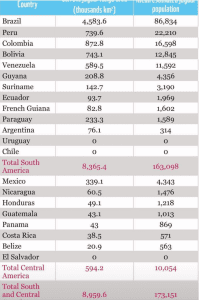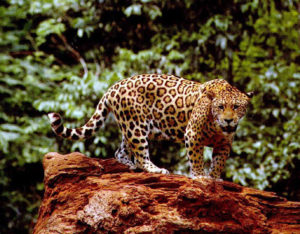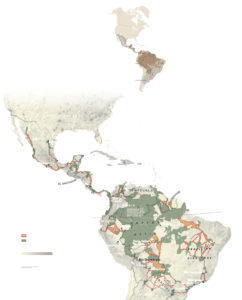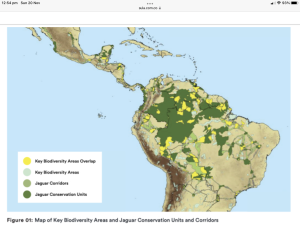Jaguar
It is estimated that there are still over 170,000 Jaguars left in the wild 160 000 in South America and 10 000 in Central America.




Jaguars are found in central and south america.
They inhabit jungle areas from Mexico to Peru. They are pretty elusive but definitely there.
Good areas to see them are the upper amazon in Peru and Brazil , Pantanal Cuiabá River Dry season is June to October Três Irmãos river in the Pantanal. Towards the southern region is Caiman Lodge , the Oncafari project monitors wild Jaguars and releases rescued cats into the wild.
1. Cuiabá River, northern Pantanal, Brazil By far the best place to see jaguars in the Pantanal (and therefore the world) is Matto Grosso, and specifically in the vicinity of Porto Jofre along the Cuiabá River. Here jaguars commonly lounge along the riverbanks and are fairly accustomed to the presence of people. particularly from the middle to the late dry season.Jaguars are sometimes also encountered along the Transpantaneria and along the Miranda River in Matto Grosso du Sol.The Cuiabá and its tributaries also offer decent odds of seeing giant otters. Meanwhile, the savannas of Matto Grosso du Sol set you up for possibly spotting such cerrado beasts as giant anteaters, maned wolves, and pampas deer. The world’s largest wetland, a vast floodplain spanning some 170,000km2, is the only area you can realistically expect to spot jaguar (though even here sightings are never guaranteed).Encounters in the Pantanal are much more common and last longer than in other locations – the jaguars tend to be twice as large as in the Amazon, too.
To maximise your chances of a sighting, take a boat ride on the Cuiabá River towards the end of the dry season (June to October), when the floods have receded and the predators head to the riverbanks to hunt capybara and caiman.The Paraguay River around Taiamã Reserve is another hot spot. It’s possible to stay on a floating hotel here to maximise opportunities for sightings.
Caiman Ecological Reserve, southern Pantanal, Brazil Though sightings are more common in the north, jaguars thrive through much of the Pantanal, 80% of which is in Brazil, the rest shared between Bolivia and Paraguay.At Caiman Lodge farther south, the Onçafari Project – which fosters ecotourism, monitors wild jaguars and releases rescued cats into the wild – is experiencing great success.Guests staying in the high-end accommodation at this former cattle ranch report high sighting rates of well over 90%! Spend a day with the team working to habituate individual cats to human presence, and you have a very good chance of an encounter. It’s claimed jaguars are seen almost daily during the dry season (June to October).You are also very likely to see anteater, hyacinth macaw, capybara and blue fronted parrot.
Calakmul Biosphere Reserve, Mexico Calakmul is best known for the vast Maya city that once flourished here – with a population of around 200,000 at its peak during the first millennium AD, and two of the largest pyramids in Mesoamerica.Now, this site in the Yucatán is home to five of Mexico’s six wild cat species: puma, margay, jaguarundi, ocelot and perhaps 200 to 500 jaguars. It also hosts agouti rodents, coati, tapir and howler monkey, plus around 350 bird species.Given that the reserve spans over 7,200km2 of the Selva Maya Rainforest, tracking one of the big cats is extremely difficult. Still, join an early morning walk and you’re likely to see wild turkey, peccary, toucan and howler monkey (which you’ll certainly hear), and possibly jaguar pugmarks.
Mexico in the Yucatan Peninsular, Honduras, Costa Rica, Manu national park in Peru.
Colombia , Cabildo Verde, a nature reserve in Sabana de Torres, Colombia.Also Casanare Hato La Aurora in Hato Corozal in The Orinoco river basin.The jaguar is one of the motifs in more than 80 sites of ancient rock art discovered in Colombia’s Chiribiquete National Park some 20,000 years old. 4.2 per 100km2 in Amacayacu national park, 3 per 100km2 in unprotected Amazon and Magdalena Medio region, and 2 per 100km2 in Llanos.
Cockscomb national park in Belize Cockscomb is the world’s first reserve created specifically to protect jaguar. Designated in 1986, largely thanks to the work of renowned conservationist Alan Rabinowitz, the sanctuary comprises of 400km2 of mostly tropical moist forest on the eastern slopes of the Maya Mountains in central Belize.The best way to explore is on foot, along the varied trails that lace the reserve. Watch for tapir, ocelot, coati, boas and profuse birdlife. Ideally, camp there to experience the most peaceful (yet bustling with wildlife) dusk and dawn periods. Kayaking is also possible.You might spot signs of jaguar activity, perhaps paw prints. Do manage expectations of a sighting, which even here is very rare. Note that the long rainy season, from June to January, is best avoided.
Iwokrama Forest, The Guyana Shield The site of an innovative project trialling sustainable forest management, Iwokrama is a 3,710km2 swathe of tropical forest in the verdant Guiana Shield that’s home to giant river otter, Guianan cock of the rock, black caiman, huge harpy eagle and – yes – jaguar. Indeed, the BBC filmed here for its 2008 series Lost Land Of The Jaguar.
With a range of activities on offer, including nocturnal caiman-spotting boat rides, various nature trails and a canopy walkway, there are ample opportunities for spotting more common species, and jaguar are seen reasonably frequently. As with many of these destinations, this is dense forest so spotting big cats is a bonus rather than a given. Avoid visiting during the heavy rains (May to August), too.
Manú National Park, Peru The Amazonia subpopulation of jaguar comes to an estimated 57,000, according to the IUCN – nearly 90% of the overall total. That said, spotting any kind of mammal in the rainforest is a tall order, let alone one as elusive as the jaguar.For the best (albeit slim) chance of an encounter, head to one of the Peruvian reserves deep in the Amazon near Puerto Maldonado. Manú National Park, a 17,000km2 biosphere reserve, is a hot spot – visit a clay lick at dawn to watch macaws and tapir, and cross your fingers that a jaguar emerges from the jungle.Tambopata National Reserve, around 200km east, is another good place for macaw licks, and also hosts jaguars. It’s contiguous with Madidi National Park in neighbouring Bolivia.
Corcovado National Park, Costa Rica Costa Rica is one of the world’s greenest countries, both literally and figuratively. Some 25% of its territory is protected in national parks or private reserves, over half of its land is covered with trees, and it’s home to 5% of the Earth’s biodiversity.Unsurprisingly, jaguar roam Costa Rica’s forests – but that doesn’t mean they’re commonly spotted. Incredibly, hunting was legal here until the 1980s, and as a result the big cats are extremely shy.Sightings do occur in the Talamanca Mountains and coastal national parks, but they’re extremely rare. One place that certainly hosts a population is Corcovado National Park, in the far south.Tackle one of the walking trails, and you may see fresh jaguar prints in the mud. You’ll also probably spy agouti, coati, possibly margay and perhaps Baird’s tapir. Be prepared for hot, sweaty hiking and serious jungle camping.One place in Costa Rica you’re guaranteed a sighting is at Las Pumas Rescue Centre in Guanacaste, in the north-west. The rescue centre homes cats, including two jaguars, who can’t be returned to the wild.
Alan Rabinowitz broadly calls the “jaguar cultural corridor.” This domain encompasses the habitats and migration paths that his conservation organization, Panthera, is trying to protect to ensure the survival of the estimated 100,000 jaguars and the vitality of their gene pool.
